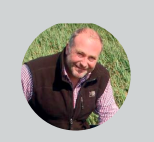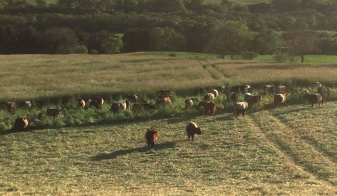
We have been farming in South Northumberland for the past 5 generations and I am in partnership with my father. The farm is primarily mixed livestock and arable with a haulage and commercial grain drying and storage facility. The farm changed dramatically in the early 90’s with ceasing milk production of a 200 cow herd and that’s when the main focus turned to combinable crop production. Livestock has always been part of our farming business and today we run 150 suckler cows plus followers.
There is 806 ha of arable and 285 ha of grass land plus woodland. The farm sits at an altitude of 220m ranging from 20m to 300m. The soil type is mostly a sandy silty loam and high magnesium levels, which can be challenging due to our location and annual average rainfall of 750mm per year. Since ceasing our milk production, it didn’t take long for us to notice a significant difference in soil conditions with more difficult crop establishment and not realising the value of grass and fym in the farm’s rotation.
We have been on this regen/conservation ag journey since the late 90’s, without us probably realising it at the time moving to a so-called min-till system, as we were more focused on reducing costs and increasing work rates. By the early 2000’s we soon realised the damage we were doing to our fragile soils with our heavy cultivation methods and that they were not sustainable. At that point we changed our methods to a more minimal scratch tillage system with a greater focus on soil health and trying to build carbon to stabilise our soils. Previously we had removed all our crop residue so we decided to start chopping more within the rotation with the aim to leave most of the residue on the surface for soil protection and not to incorporate at depth as the residue would easily turn anaerobic. We were still rotationally ploughing at this stage probably 25-30% of the farm, mainly because of our rotation and narrow window for winter crop establishment. This continued for a number of years, while at the same time trying some different approaches to enable us to widen our rotation introducing some spring cropping.

Our first overwinter cover crop was grown in 2006 just a simple oat and mustard mix cultivated in that autumn and spring beans no-tilled in the following spring, which was not that successful as due to the lack of our cover crop knowledge, the crop was holding onto the moisture and we were more concerned about the date of drilling rather than the conditions.
It was not until the harvest and autumn of 2008, which was extremely wet again where virtually no winter crop was drilled. With the prospect of having to plant 100% spring crop that was probably when the penny dropped, that if we wanted to continue down a reduced tillage system to improve our soils health we would need to widen our rotation and that would be the year to do so. The harvest of 2009 proved that we could grow spring crops successfully. We continued to experiment with cover crops, spring cropping and direct drilling till 2012, where we had another extremely wet autumn with the only winter cereals established were on those fields that had not been inverted since the late 90’s and which had applied straw, fym and gypsum over the years.

That November of 2012 another light bulb moment occurred, not knowing what to expect, I was asked to join a meeting at Newark to listen to a French man called Frederic Thomas. I came away from that meeting with a more focused direction of where conservation agriculture could take us. From that point we took the decision to move to a nearly total no-till system. Also, from that meeting we saw the start of BASE-UK as a organisation. I felt so very privileged to be asked to be involved in the organisation from the start. I have had the opportunity to meet some fantastic people over the years that are so passionate, enthusiastic and knowledgeable in conservation agriculture and in turn has given me the confidence to continue down the path that has been quite controversial and not always easy at times.
The changes have been quite dramatic both in the arable and livestock part of the business. We have moved to growing between 20-40% spring crops following our autumn established cover crops, which has also allowed opportunities to import more organic matter onto the farm in the form of compost and applying more gypsum with the compost. Our rotation has changed from a wheat, barley, oilseed rape autumn drilled to a wheat, oats, linseed, beans and oilseed rape autumn drilled, and spring drilled oats, beans, barley and peas. Also playing around with peas and oilseed rape mixes. We are still doing some cultivating probably about 5% within the rotation to level fields to improve the following crop establishment. Overall, this seems to have brought more diversity to the farm enabling our soils to become more resilient to extreme weather (still not perfect) but yet in another very wet harvest and autumn we have more winter crop established which I feel is down to the change in our methods of farming.

All spring crops have a starter fertiliser applied with the drill as a liquid and we have both a disc and a tine drill which enables flexibility in both winter and spring establishment. Our drive has been to try and reduce costs while still maintaining output – we have been mixing our own liquid fertiliser for a number of years, we have stopped spraying insecticides and we are trying to reduce our other pesticide use. Also home saving the majority of our seed as we have the facilities to clean and dress (recently we have moved away from applying any seed dressings with no detriment to the growing crop) which has also made life more simple as we have no seeds sitting in bags with dressing on (especially this year).
Historically the livestock have nearly always been run as a totally separate enterprise. Recently we have been growing forage rye for early grazing on arable ground where we have calved the herd in late April/early May. We are also growing westawold and clover to again graze in early April which helps clean our fields up where we have brome that is causing problems in the arable rotation, in turn is also resting our pastures so we are not chasing grass early in the growing season. It is still early days but this has given us the confidence to try some mob grazing with the herd but it is not without its problems as water and fencing are the main hurdles to overcome. On a positive note however, the temperament of the cattle has changed dramatically, they are so much easier to work with.
Looking forward and following on from a difficult autumn, I am more confident and relaxed with the quantity of spring cropped area we are going to have this year due to the experience I have gained over the past number of years. We still have many improvements to make as it often does feel like we have taken three steps forward and three steps back because of the altitude and the soil type we have to deal with but I’m sure this will improve over time as there is an awful lot more to learn.